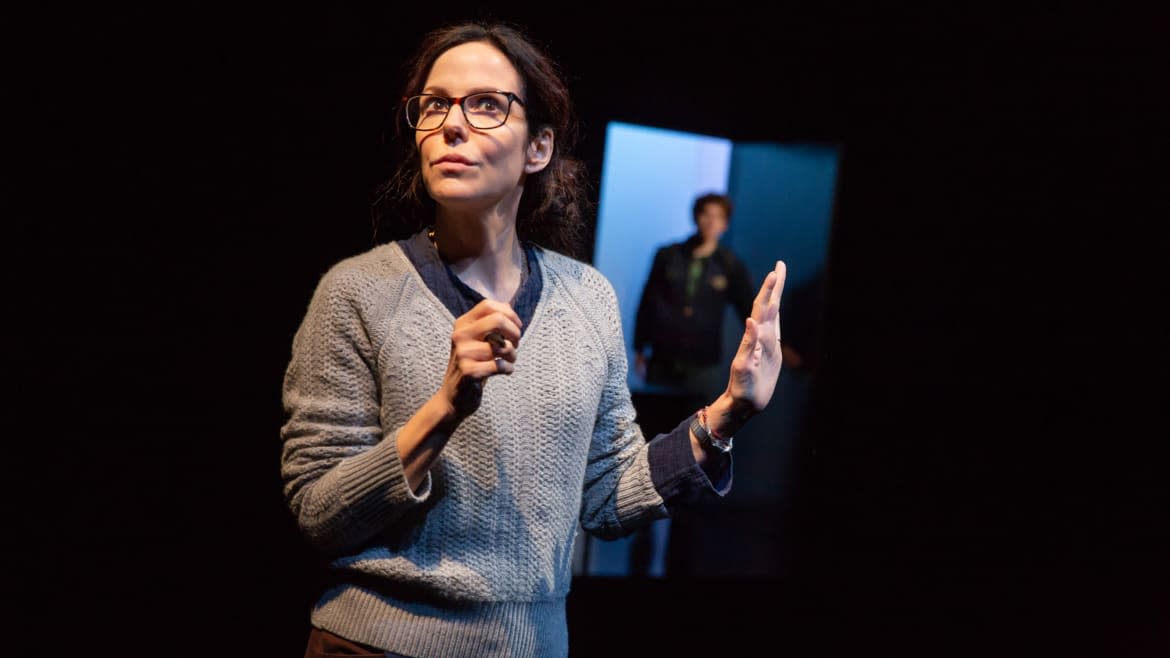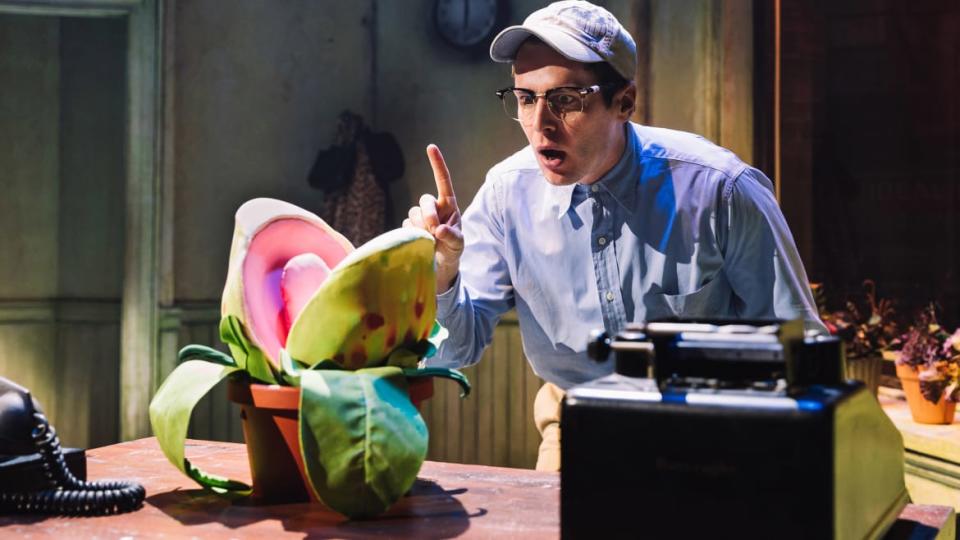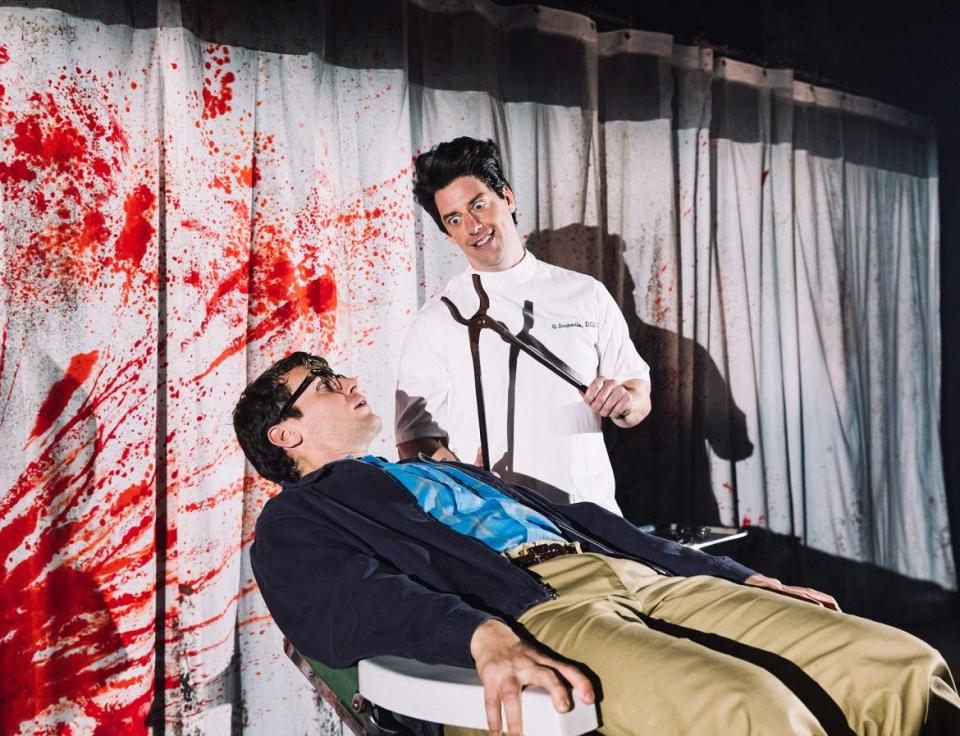Mary-Louise Parker Confronts ‘The Sound Inside,’ and—Feed Me!—‘Little Shop of Horrors’ Is Back For Blood

The shifty complexity of Adam Rapp’s The Sound Inside, which opens tonight on Broadway at Studio 54 (to Jan. 12, 2020), is signaled right from the start. Mary-Louise Parker’s character appears like a ghost from the gloam of a blacked-out stage. She very literally takes shape before our eyes, and even then the stage stays mainly black, the characters lit simply and starkly in white light by Heather Gilbert.
Throughout the show, Alexander Woodward’s sets of academic office and living room and bar appear, spartanly realized, and then disappear back into blackness; Aaron Rhyne’s occasional projections, of a park for example, bloom and then erase themselves.
Mary-Louise Parker: ‘The World Doesn’t Need Another Mean Book. And I Do Love Men.’
Obie winner and Pulitzer finalist Rapp has not created a conventional ghost story, but it feels like one, or rather a story populated by ghosts or pliable figments of an imagination.
The play is backed by Lincoln Center Theater and the Williamstown Theatre Festival, where it was first staged last year. Directed with freighted restraint by David Cromer, it is only 90 minutes but it certainly lingers longer. It feels like a long dark night of two scarred souls.
Parker plays Bella Lee Baird, a Yale professor of creative writing, who is trying to deal with a life-changing, potentially fatal cancer diagnosis. Into her office comes Christopher Dunn (Will Hochman, making his Broadway debut), a strange student who runs in his own pack of one, spits on her floor, and who has great contempt for artisanal coffee and the tattooed people who make it. His denunciation of coffee culture and the internet is stinging and very funny.
He notes that she is friendless; she counters that she plays tennis with a fellow academic, but cannot name her. These two lost souls, witty, sharp and relentless in their own ways, who both love literature, are drawn to one another’s intensely passionate commitment to the written word.
Parker, who won a Tony Award in 2001 for Proof and who was last seen on Broadway in Heisenberg in 2016, gives a spare and rigorous performance here; she is the embodiment of the independent, ascetic person of letters. She is questioning and sharp. Hochman plays Will as a shuffling bag of moods: funny, intense, and then terrifying.
They’re so in the moment, you may find yourself holding your breath, glad that they found each other, and slightly terrified about where their relationship may lead. And if you know Yale, then you’re going to be in many-references-to-New Haven heaven.
Both characters are working on creating stories. As Bella tells us what happened to them both, she is also composing notes in a pad about what happened too. Christopher too is writing his own story, about a young man, who may or not be him, who ends up in New York City, committing a terrible act.
What is real and what is fiction is as obscuring as the blackness of the stage. A sense of danger builds, as Bella contemplates suicide to escape the pain she is enduring, and she enlists Christopher’s help to do it.
There are many unknown terrors in The Sound Inside, the title coming from a phrase that enters and won’t leave Bella’s mind. There is the terror of intimacy and being truthful about one’s life; the terror of artistic creation, of self-invention and self-annihilation; the terror of exposure in person and on the page; a terror of mortality, loneliness, and vulnerability. The latter terror comes to haunt Bella most keenly as the play’s closing moments unfold. Did she really know Christopher? How do any of us know each other?
Like the sets on stage, Rapp’s story advances to us, and then recedes into its own shadows. It is both involving and repelling, and like the best ghost story Rapp and his players ensure that you’re left both unsettled long after the play is subsumed again by darkness.

Jonathan Groff as Seymour and Audrey II in 'Little Shop of Horrors'
Little Shop of Horrors
You will lose count of the number of characters that the amazing Christian Borle plays in Michael Mayer’s revival of Little Shop of Horrors at Westside Theatre (through Jan. 19). But Borle is most funny, and menacing as Orin the dentist, Audrey’s (Tammy Blanchard) abusive boyfriend and the first human to be fed to the notorious murderous plant, Audrey II (voiced by Kingsley Leggs), by hapless murderer Seymour (Jonathan Groff). That’s after Borle has played Orin as off-his-face on nitrous oxide.
This is a wonderful off-Broadway production—with music and orchestrations by Will Van Dyke and choreography by Ellenore Scott—that revels tunefully in this absurd tale’s ever-increasing extremity. Little Shop has a big history. The 1986 movie starring Rick Moranis was based on this 1982 stage musical, with book and lyrics by the great Howard Ashman and music by Alan Menken. And the 1982 stage musical is originally derived from Roger Corman’s cult, low-budget 1960 movie.
This new production is slick and hilarious, designed with attractive whimsy by Julian Crouch. It opens with the Greek chorus of Ronnette (Ari Groover), Crystal (Salome Smith), and Chiffon (Joy Woods) introducing us to Mushnik’s (Tom Alan Robbins) dowdy flower shop, which is in danger of closing without fresh business.

Jonathan Groff as Seymour, in chair, and Christian Borle as Orin in 'Little Shop of Horrors'
Well, luckily dweeb of dweebs Seymour has been nursing a strange plant to health. It appears alive, and this mystery monster brings customers and publicity. The problem is it needs blood to live. “Feed me,” it booms terrifyingly, and so it must be fed with flesh—and dweeb Seymour becomes a serial killer in order to keep this bloody fertilizer flowing.
Nicholas Mahon and Eric Wright, Teddy Yudain, Kris Roberts, and Chelsea Turbin operate Audrey II from its cute infancy to its terrifying mega-size, as it swallows humans whole, and lolls its massive head towards us—and there is even a final great Audrey II visual surprise as the lights come down and the puppet advances menacingly to our seats. The raucous craziness of Little Shop remains intact; go be eaten whole by it.
Get our top stories in your inbox every day. Sign up now!
Daily Beast Membership: Beast Inside goes deeper on the stories that matter to you. Learn more.

